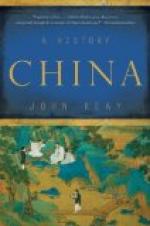This popular rising, which had only been overcome with the aid of foreign troops, brought the end of the T’ang dynasty. In 885 the T’ang emperor was able to return to the capital, but the only question now was whether China should be ruled by the Sha-t’o under Li K’o-yung or by some other military commander. In a short time Chu Ch’uean-chung, a former follower of Huang Ch’ao, proved to be the strongest of the commanders. In 890 open war began between the two leaders. Li K’o-yung was based on Shansi; Chu Ch’uean-chung had control of the plains in the east. Meanwhile the governors of Szechwan in the west and Chekiang in the south-east made themselves independent. Both declared themselves kings or emperors and set up dynasties of their own (from 895).
Within the capital, the emperor was threatened several times by revolts, so that he had to flee and place himself in the hands of Li K’o-yung as the only leader on whose loyalty he could count. Soon after this, however, the emperor fell into the hands of Chu Ch’uean-chung, who killed the whole entourage of the emperor, particularly the eunuchs; after a time he had the emperor himself killed, set a puppet—as had become customary—on the throne, and at the beginning of 907 took over the rule from him, becoming emperor in the “Later Liang dynasty”.
That was the end of the T’ang dynasty, at the beginning of which China had risen to unprecedented power. Its downfall had been brought about by the military governors, who had built up their power and had become independent hereditary satraps, exploiting the people for their own purposes, and by their continual mutual struggles undermining the economic structure of the empire. In addition to this, the empire had been weakened first by its foreign trade and then by the dependence on foreigners, especially Turks, into which it had fallen owing to internal conditions. A large part of the national income had gone abroad. Such is the explanation of the great popular risings which ultimately brought the dynasty to its end.
MODERN TIMES
Chapter Nine
THE EPOCH OF THE SECOND DIVISION OF CHINA
(A) The period of transition: the Five Dynasties (A.D. 906-960)
1 Beginning of a new epoch
The rebellion of Huang Ch’ao in fact meant the end of the T’ang dynasty and the division of China into a number of independent states. Only for reasons of convenience we keep the traditional division into dynasties and have our new period begin with the official end of the T’ang dynasty in 906. We decided to call the new thousand years of Chinese history “Modern Times” in order to indicate that from c. 860 on changes in China’s social structure came about which set this epoch off from the earlier thousand years which we called “The Middle Ages”. Any division into periods is arbitrary as changes do not happen from one year to the next. The first beginnings of the changes which lead to the “Modern Times” actually can be seen from the end of An Lu-shan’s rebellion on, from c. A.D. 780 on, and the transformation was more or less completed only in the middle of the eleventh century.




